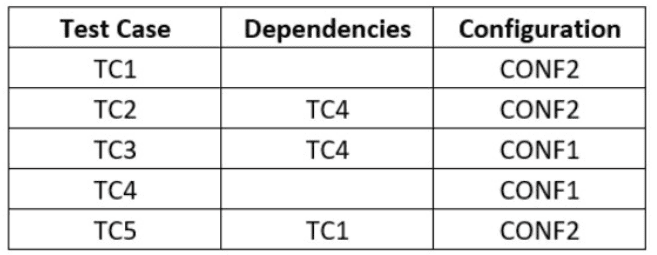iSQI CTFL_Syll_4.0 - ISTQB Certified Tester Foundation Level (CTFL) v4.0
Which sequence of state transitions is INCORRECT in accordance with the following description?
To provide for disaster recovery a system (designated as A) has been provided with a backup system (designated as B). Only one of them can be active at a time. When A goes down, B becomes active. When A comes back up then B becomes inactive and A becomes active again. However, when A is down and B also goes down then a message is sent to the system administrator. After this once A comes back up, A becomes active or if B comes up then B becomes Active.
Which ONE of the following tools would be MOST SUITABLE for facilitating thecreation of test cases, test data, and test procedures?
A typical test objective is to:
For each test case to be executed, the following table specifies its dependencies and the required configuration of the test environment for running such test case:

Assume that CONF1 is the initial configuration of the test environment. Based on this assumption, which of the following is a test execution schedule that is compatible with the specified dependencies and allows minimizing the number of switches between the different configurations of the test environment?
The acceptance criteria associated with a user story:
Consider a review for a high-level architectural document written by a software architect. The architect does most of the review preparation work, including distributing the document to reviewers before the review meeting. However, reviewers are not required to analyze the document in advance, and during the review meeting the software architect explains the document step by step. The only goal of this review is to establish a common understanding of the software architecture that will be used in a software development project.
Which of the following review types does this review refer to?
Which of the following statements is true?
Which ONE of the following statements is correct?
Which ONE of the following options BEST describes the purpose of confirmation testing versus regression testing?
Which ONE of the following options is NOT a test objective?



